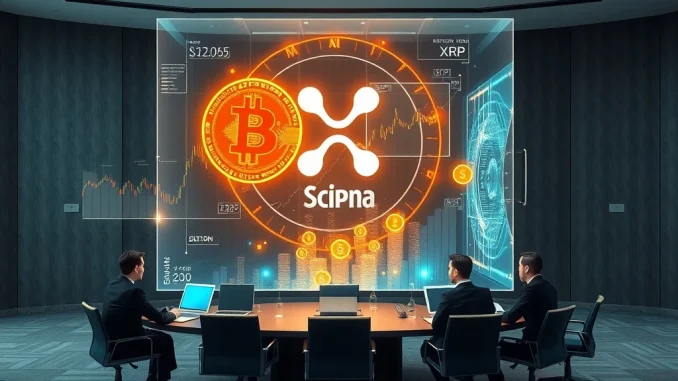
A quiet revolution is sweeping through the corporate world, fundamentally reshaping how traditional companies manage their financial assets. Once considered niche or speculative, cryptocurrencies like Bitcoin, XRP, and Solana are now emerging as strategic reserves within corporate treasuries. This significant shift signals a maturing perception of digital assets, moving them from the fringes to the core of enterprise financial planning. It’s a compelling narrative for anyone interested in the future of finance and the evolving role of digital currencies.
Why Bitcoin is Becoming a Corporate Cornerstone
For many traditional businesses, Bitcoin has become the gateway into the crypto space. Its reputation as ‘digital gold’ and a potential hedge against inflation makes it an attractive asset for long-term holding. Companies are increasingly viewing Bitcoin not just as a speculative investment, but as a foundational component of their corporate treasury strategy, similar to how they might hold gold or other commodities.
- Inflation Hedge: In an era of economic uncertainty, Bitcoin’s capped supply makes it appealing as a store of value, protecting purchasing power against currency debasement.
- Diversification: Adding Bitcoin provides a new layer of diversification to traditional portfolios, offering exposure to a rapidly growing asset class.
- Strategic Positioning: Holding Bitcoin can signal a company’s forward-thinking approach, potentially attracting tech-savvy investors and talent.
Consider Matador Technologies, which secured board approval to accumulate 6,000 BTC by 2027, explicitly positioning Bitcoin as a hedge against inflation. Even larger entities, like Trump Media Group, have made substantial Bitcoin purchases, highlighting how corporate giants are integrating crypto into their financial strategies. This trend demonstrates a clear move towards legitimizing Bitcoin within established financial frameworks.
The Rise of Corporate Crypto Treasuries: Beyond Just Bitcoin
While Bitcoin often leads the charge, the broader trend of corporate crypto adoption extends far beyond BTC. Companies across diverse sectors—from agriculture and consumer manufacturing to textiles—are diversifying their digital asset holdings to include a range of altcoins. This reflects a more sophisticated understanding of the crypto market, where different assets serve different strategic purposes.
This expansion into altcoins suggests a nuanced approach to digital asset management. Companies are not just buying crypto; they are strategically selecting assets based on their utility, performance, and potential within specific blockchain ecosystems. This diversification helps spread risk while capitalizing on the unique strengths of various cryptocurrencies.
XRP’s Strategic Role in Corporate Holdings
Among the altcoins gaining traction, XRP stands out for its unique utility. Designed for fast, low-cost international payments, XRP offers a compelling proposition for companies involved in cross-border transactions or seeking efficient liquidity solutions. Nature’s Miracle, an agricultural technology firm, recently announced a significant $20 million XRP treasury allocation. This move is particularly notable as it represents one of the first public altcoin treasury strategies of its kind.
XRP’s appeal lies in its:
- Speed and Efficiency: Transactions on the XRP Ledger are nearly instantaneous and significantly cheaper than traditional banking rails.
- Bridging Asset: XRP can act as a bridge currency for international payments, reducing the need for pre-funded nostro/vostro accounts.
- Institutional Focus: Ripple, the company behind XRP, has a strong focus on enterprise solutions, making XRP a natural fit for corporate use cases.
This strategic allocation underscores a growing recognition of XRP’s potential to optimize treasury operations and enhance global financial flows.
Solana’s Appeal: High Performance for Corporate Reserves
Another altcoin capturing corporate attention is Solana (SOL). Known for its high throughput and low transaction costs, Solana’s blockchain infrastructure is highly scalable, making it attractive for applications requiring rapid processing and large transaction volumes. Upexi, a consumer manufacturing company, acquired 83,000 SOL, valued at $16.7 million, for its reserves. This highlights Solana’s emerging role as a viable option for corporate treasuries.
Solana’s advantages for corporate adoption include:
- Scalability: Capable of handling thousands of transactions per second, Solana can support large-scale enterprise operations.
- Low Fees: The minimal transaction fees make it economically viable for frequent operations and long-term holding.
- Developer Ecosystem: A robust and growing ecosystem of decentralized applications (dApps) built on Solana indicates its long-term potential and utility.
Companies are recognizing Solana’s potential not just as an investment, but as a platform that could support future business models and digital interactions, making it a valuable addition to a diversified crypto treasury.
Navigating the Crypto Treasury Landscape: Risks and Rewards
The burgeoning trend of companies embracing a crypto treasury strategy comes with both significant opportunities and inherent challenges. While the potential for appreciation and novel liquidity management is appealing, the volatility of digital assets introduces considerable risks that require specialized expertise.
Opportunities:
- Potential Appreciation: Cryptocurrencies can offer substantial returns, enhancing overall corporate value.
- Enhanced Liquidity: Digital assets can provide alternative avenues for liquidity management, especially in global markets.
- Market Influence: Corporate adoption can normalize crypto, influencing regulatory debates and market liquidity dynamics positively.
Challenges:
- Volatility: Crypto markets are known for sharp price swings. A recent report from venture capital firm Breed warned that even minor Bitcoin price drops could trigger a ‘death spiral’ for overleveraged crypto treasury companies, forcing asset sales to meet debt obligations and exacerbating downward price trends.
- Regulatory Scrutiny: The regulatory landscape for digital assets is still evolving, posing compliance risks. For instance, DDC Enterprise’s $500 million shelf registration to fund Bitcoin acquisitions sparked a 20% stock surge but also drew scrutiny over whether such investments align with long-term value creation.
- Lack of ‘Floor’ for Altcoins: As content creator Viktor emphasized, altcoins often lack the ‘floor’ of Bitcoin, making them potentially more vulnerable to sharp declines when market cycles reverse.
- Operational Risks: Managing crypto holdings requires robust cybersecurity, secure storage solutions, and expertise in blockchain technology.
Companies embarking on this path must develop sophisticated risk management frameworks, continuously monitoring legal, operational, and market risks. The success of these strategies will depend heavily on macroeconomic factors, regulatory clarity, and the continued performance of digital assets against traditional benchmarks.
The Future of Corporate Finance: A Digital Transformation
The increasing allocation of corporate treasuries to Bitcoin, XRP, and Solana signifies a profound shift in corporate finance. It reflects a maturing perception of digital assets as legitimate, albeit volatile, components of a diversified financial portfolio. From agricultural tech firms to established Japanese textile companies and media giants, the willingness to embrace crypto as a strategic reserve asset is growing. While still in its early stages, this trend is normalizing crypto holdings within traditional corporate structures, treating them akin to traditional cash reserves but with higher speculative potential. As more firms enter the crypto treasury space, the stability of the market and the viability of these innovative strategies will continue to be tested and refined, paving the way for a more digitally integrated financial future.
Frequently Asked Questions (FAQs)
Why are traditional companies investing in cryptocurrencies?
Traditional companies are investing in cryptocurrencies for several strategic reasons, including diversifying their treasury reserves, hedging against inflation (especially with Bitcoin), seeking potential appreciation, and positioning themselves as forward-thinking innovators in the digital economy. It’s also seen as a way to optimize liquidity management and prepare for a future where digital assets play a more central role in global finance.
What are the main cryptocurrencies companies are holding in their treasuries?
While Bitcoin (BTC) remains the dominant choice due to its status as ‘digital gold’ and a store of value, companies are increasingly diversifying into altcoins. XRP is being adopted for its utility in cross-border payments, and Solana (SOL) is gaining traction due to its high scalability and low transaction costs, making it attractive for high-performance applications.
What are the risks involved in corporate crypto treasuries?
The primary risks include high market volatility, which can lead to significant fluctuations in asset value. Regulatory uncertainty also poses a challenge, as the legal framework for digital assets is still evolving. Additionally, there are operational risks related to cybersecurity, secure storage, and the need for specialized expertise in managing digital assets. Overleveraged positions can also lead to forced asset sales during price drops.
How does this trend impact the broader crypto market?
The increasing corporate adoption of cryptocurrencies as treasury reserves lends significant legitimacy to the crypto market. It can increase market liquidity, attract more institutional investors, and potentially reduce overall volatility as more stable, long-term holders enter the space. This trend also influences regulatory discussions, pushing for clearer guidelines and greater acceptance of digital assets in mainstream finance.
Is this trend of corporate crypto adoption likely to continue?
Many analysts believe the trend is likely to continue and even accelerate. As the crypto market matures, regulatory clarity improves, and more companies witness the benefits and manage the risks effectively, digital assets are expected to become an even more integrated part of corporate financial infrastructure. The examples set by early adopters are paving the way for broader institutional acceptance.



